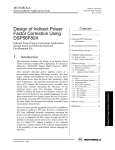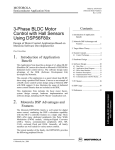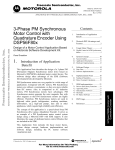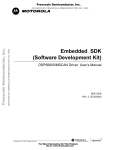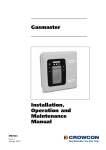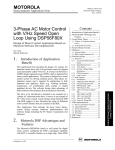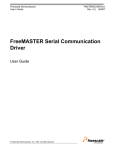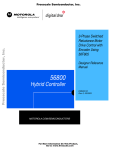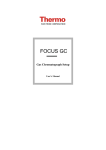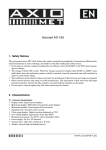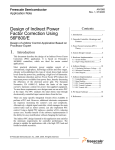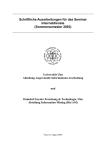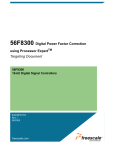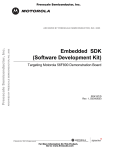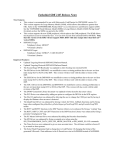Download AN1918 Application Note
Transcript
Freescale Semiconductor, Inc. MOTOROLA Order by AN1918/D (Motorola Order Number) Rev. 0, 6/01 Indirect Power Factor Correction for 3-Phase AC Motor Control with V/Hz Speed Open Loop Application Using DSP56F80x Design of Indirect Power Factor Correction Contents 1. Introduction of Application Benefit ...1 2. Motorola DSP Advantages and Features .................................... 2 3. System Design Concepts............... 3 4. Hardware Implementation ............. 5 4.1 System Outline ............................... 5 4.2 High Voltage Hardware Set............ 5 5. Software Implementation .............. 7 1. Introduction of Application Benefit This Application Note describes the design of a Indirect Power Factor Correction (Indirect PFC) for 3-phase AC Motor V/Hz Speed Open Loop application. It is based on Motorola’s 56F80X digital signal processor (DSP) which is dedicated for motor control applications. Most practical electronic power supplies consist of a conventional single-phase full-bridge rectifier and filter stages. As is well-known, this type of circuit draws high current levels from the power line and produces a high level of harmonics. This harmonic distortion and low power factor (PF) reduce the maximum power available from the power lines and reduce the efficiency of the electrical supply networks. The European Normative EN 61000-3-2 defines the limits of the harmonic content of the input current for the power line supplied equipment. To meet these requirements, new designs require the use of an active power factor correction (PFC) at the input. The PFC emulates the ideal ohmic load by electronically controlling input current drawn from the line. 5.1 Files ................................................ 7 5.2 Drivers and Library Function ......... 8 5.3 Appconfig.h File ............................. 8 5.4 PFC Control Integration ................. 8 5.4.1 Resources ................................... 8 5.4.2 Modification ............................... 8 5.4.3 Initialization ............................... 9 5.4.4 PFC Control Enable ................... 9 5.4.5 PFC Control Disable .................. 9 5.5 Input Current Harmonics Contents. 9 6. PC Master .................................... 10 7. Memory Usage ............................ 10 8. References ................................... 11 There are many specific ICs available on the market to do the PFC task. Those approach require additional electronic components, increasing the system cost and complexity. On the other hand, there is a way to implement PFC control © Motorola, Inc., 2001 For More Information On This Product, Go to: www.freescale.com Indirect Power Factor Correction Freescale Semiconductor, Inc... Semiconductor Application Note Freescale Semiconductor, Inc. Motorola DSP Advantage and Features through the DSP in addition to the main control tasks like motor control, etc. The use of a digital PFC replaces a number of ICs and reduces the system cost. Another benefit of the software implementation is easy modification without changing the hardware. 2. Motorola DSP Advantage and Features The members of the Motorola DSP56F80x family are well suited for digital motor control, combining the DSP’s calculation capability with an MCU’s controller features on a single chip. These DSPs offer many peripherals, including Pulse-Width-Modulation (PWM) unit, Analog-to-Digital Converter (ADC), Timers, communication peripherals (SCI, SPI, CAN), on-board Flash and RAM. Freescale Semiconductor, Inc... The typical member of the family, the DSP56F805, provides the following peripheral blocks: • Two Pulse Width Modulator modules (PWMA & PWMB), each with six PWM outputs, three Current Status inputs, and four Fault inputs, fault tolerant design with deadtime insertion, supports both Center- and Edge- aligned modes • Twelve-bit Analog to Digital Convertors (ADCs), supporting two simultaneous conversions with dual 4-pin multiplexed inputs; ADC can be synchronized by PWM modules • Two Quadrature Decoders (Quad Dec0 & Quad Dec1), each with four inputs, or two additional Quad Timers A & B • Two dedicated General Purpose Quad Timers totalling 6 pins: Timer C with 2 pins and Timer D with 4 pins • CAN 2.0 A/B Module with 2-pin ports used to transmit and receive • Two Serial Communication Interfaces (SCI0 & SCI1), each with two pins, or four additional GPIO lines • Serial Peripheral Interface (SPI), with configurable 4-pin port, or four additional GPIO lines • Computer Operating Properly (COP) timer • Two dedicated external interrupt pins • Fourteen dedicated General Purpose I/O (GPIO) pins, 18 multiplexed GPIO pins • External reset pin for hardware reset • JTAG/On-Chip Emulation (OnCE) • Software-programmable, Phase Lock Loop-based frequency synthesizer for the DSP core clock • Memory configuration — 32252 × 16-bit words of Program Flash — 512 × 16-bit words of Program RAM — 2K × 16-bit words of Data RAM — 4K × 16-bit words of Data Flash — 2K × 16-bit words of Boot Flash Other than the fast Analog-to-Digital converter and 16-bit Quadrature Timers, the most interesting peripheral from a motor control point of view is the Pulse Width Modulation (PWM) module. Its configuration permits efficient control of AC motors. 2 Indirect Power Factor Correction For More Information On This Product, Go to: www.freescale.com Freescale Semiconductor, Inc. System Design Concepts Freescale Semiconductor, Inc... The PWM has the following features: • Three complementary PWM signal pairs, or six independent PWM signals • Complementary channel operation • Deadtime insertion • Separate top and bottom pulse width correction via current status inputs or software • Separate top and bottom polarity control • Edge-aligned or center-aligned PWM signals • 15-bits of resolution • Half-cycle reload capability • Integral reload rates from one to 16 • Individual software-controlled PWM output • Programmable fault protection • Polarity control • 20-mA current sink capability on PWM pins • Write-protectable registers The AC Motor control utilizes the PWM block set in the complementary PWM mode, which configures the PWM output as a pair of complimentary channels. 3. System Design Concepts The system has all of the basic characteristics of both Digital Power Factor Correction and 3-phase AC motor V/Hz Open Loop applications described below: • Motor Control — Targeted for DSP56F803/805EVM platforms — Running on 3-phase AC/BLDC Motor Control Development Platform at single line voltage 360V DC +/- 10% — Control technique incorporates — V/Hz speed open loop — bi-directional rotation — motoring and regenerating mode — Overvoltage, Undervoltage, Overcurrent, and Temperature Fault protection — PC Master and Manual Interface — Power Stage Identification • PFC Control — Input power supply voltage 115-230V AC — Input power supply frequency 50/60 Hz — Nominal output voltage 360V DC +/- 10%. — Nominal output power 180W — Input current harmonic content will comply with standard IEC 1000-3-2 Indirect Power Factor Correction For More Information On This Product, Go to: www.freescale.com 3 Freescale Semiconductor, Inc. System Design Concepts The system is designed to integrate PFC control with a real motor control application. The base is the 3-phase AC Motor V/Hz Speed Open Loop application. The DSP runs the main control algorithm. It generates a 3-phase PWM output signal for the motor according to the user’s input. The DSP also controls the power factor correction hardware that provides the power supply for the motor. DC-Bus 3-ph AC M Freescale Semiconductor, Inc... ~115-230V 50/60Hz pulse wide modulator & Zero crossing detection Pulse wide modulation Input frequency measurement. Milestone generation. Base frequency Inhibit output IRC Temperature, Current & Voltage sensors Temperature, voltage and fault processing F Speed set-up Speed Command Processing PWM Generator with Dead Time Reference voltage calculation V2 DC-Bus Ripple Cancel V1 PI Regulator V/Hz Speed Processing DSP56F80X Figure 3-1. System Concept The system integrates two independent parts that keep all their own features. First is a 3-phase AC motor drive with V/Hz Speed Open Loop algorithm; the second is a Power Factor Correction (PFC) algorithm (see Figure 3-1). The DSP runs the main control algorithm. According to the user interface input and feedback signals, it generates 3-phase PWM output signals for the motor inverter. The PFC provides the power for the Motor inverter. The main advantage of the power factor correction system is the reduction of electrical noise. This will be possible if the input current waveform is sine-like. The hardware does not directly control the PFC inverter switch. It modifies the PFC reference voltage only, which makes possible simple a 3-point sine approximation of the input current waveform. It is enough to comply with IEC standard and simplifies control software complexity. The second PFC feature is the stable output voltage. The PFC circit is a boost voltage converter, so output voltage cannot be less than rectified input voltage. 4 Indirect Power Factor Correction For More Information On This Product, Go to: www.freescale.com Freescale Semiconductor, Inc. Hardware Implementation 4. Hardware Implementation 4.1 System Outline The hardware is designed to drive the 3-phase AC/BLDC motor. This application notes describes PFC uses with a 3 -phase AC motor. The application can run on Motorola motor control DSPs using the DSP EVM Board: • DSP56F803 • DSP56F805 Freescale Semiconductor, Inc... The designed software is capable to run only on High Voltage Hardware Set described below. The HW setup is shown in Figure 4-1, but it is described also in the documents Targeting_DSP56803_Platform, and Targeting_DSP56805_Platform according to targeted DSP/EVM. Those documents also describe EVM jumper settings. 4.2 High Voltage Hardware Set The system configuration is shown in Figure 4-1. All the system parts are supplied and documented according the following references: • U1 - Controller Board for DSP56F805: — supplied as: DSP56805EVM — described in: DSP Evaluation Module Hardware User’s Manual • or U1 - Controller Board for DSP56F803: — supplied as: DSP56803EVM — described in: DSP Evaluation Module Hardware User’s Manual • U2 - 3 ph AC/BLDC High Voltage Power Stage — supplied in kit with Optoisolation Board as: ECOPTHIVACBLDC — described in: MEMC3BLDCPSUM/D - 3 Phase Brushless DC High Voltage Power Stage • U3 - Optoisolation Board — supplied with 3 ph AC/BLDC High Voltage Power Stage as: ECOPTHIVACBLDC — or supplied alone as: ECOPT - optoisolation board — described in: MEMCOBUM/D Optoisolation Board User’s Manual Warning: It is strongly recommended to use optoisolation (optocouplers and optoisolation amplifiers) during the development time to avoid any damage to the development equipment. • MB1 Motor-Brake AM40V + SG40N — supplied as: ECMTRHIVAC Notes: Information on all above mentioned boards and documents can be found on: http://mot-sps.com/motor/devtools/index.html Indirect Power Factor Correction For More Information On This Product, Go to: www.freescale.com 5 Freescale Semiconductor, Inc. Hardware Implementation +12VDC GND 40w flat ribbon cable, gray Optoisolation Board J1 3ph AC/BLDC High Voltage Power Stage J2 PE J1 J11.1 J11.2 J14 L N U1 U2 JP1.1 JP1.2 U3 Controller Board J13.1 J13.2 J13.3 40w flat ribbon cable, gray Freescale Semiconductor, Inc... Black White Red JP201 ECOPT 1 2 3 ECOPTHIVACBLDC MB1 Motor-Brake AM40V SG40N J5 BHK 16.05A Red White Black Incremental encoder Baumer Electric Hall sensor encoder 00126A ECMTRHIVAC Not used in application 1024-12-5 Not used in application Figure 4-1. High Voltage HW System Configuration All the system parts are supplied and documented according the following references: • U1 - Controller Board for DSP56F805: — supplied as: DSP56805EVM — described in: DSP56F805EVMUM/D DSP Evaluation Module Hardware User’s Manual • or U1 - Controller Board for DSP56F803: — supplied as: DSP56803EVM — described in: DSP56F803EVMUM/D DSP Evaluation Module Hardware User’s Manual • 6 U2 - 3 ph AC/BLDC High Voltage Power Stage Indirect Power Factor Correction For More Information On This Product, Go to: www.freescale.com Freescale Semiconductor, Inc. Software Implementation — supplied in kit with Optoisolation Board as: ECOPTHIVACBLDC — described in: MEMC3BLDCPSUM/D - 3 Phase Brushless DC High Voltage Power Stage • U3 - Optoisolation Board — supplied with 3 ph AC/BLDC High Voltage Power Stage as: ECOPTHIVACBLDC — or supplied alone as: ECOPT - optoisolation board — described in: MEMCOBUM/D Optoisolation Board User’s Manual Freescale Semiconductor, Inc... Warning: It is strongly recommended to use optoisolation (optocouplers and optoisolation amplifiers) during the development time to avoid any damage to the development equipment. Notes: Information of all above mentioned boards and documents can be found on: http://mot-sps.com/motor/devtools/index.html 5. Software Implementation The Motorola Embedded SDK is a collection of APIs, libraries, services, rules and guidelines. This software infrastructure is designed to let DSP5680x software developers create high-level, efficient, portable code. This chapter describes the minor changes needed for the basic 3-phase AC motor V/Hz Open Loop application that are necessary to integrate PFC control. 5.1 Files The application is composed of the following files: • ...\dsp5680Xevm\nos\applications\3ph_AC_VHz_OpenLoop_PFC\ \3ph_AC_VHz_OpenLoop_PFC.c (main program) • ...\dsp5680Xevm\nos\applications\3ph_AC_VHz_OpenLoop_PFC\dpfc.c (PFC control program) • ...\dsp5680Xevm\nos\applications\3ph_AC_VHz_OpenLoop_PFC\dpfc.h (PFC control header file) • ...\dsp5680Xevm\nos\applications\3ph_AC_VHz_OpenLoop_PFC\ \3ph_AC_VHz_OpenLoop_PFC.mcp (application project file) • ...\dsp5680Xevm\nos\applications\3ph_AC_VHz_OpenLoop_PFC\configflash\appconfig.c (application configuration source file for FLASH) • ...\dsp5680Xevm\nos\applications\3ph_AC_VHz_OpenLoop_PFC\configflash\appconfig.h (application configuration header file for FLASH) • ...\dsp5680Xevm\nos\applications\3ph_AC_VHz_OpenLoop_PFC\configflash\linker.cmd (linker command file for FLASH) • ...\dsp5680Xevm\nos\applications\3ph_AC_VHz_OpenLoop_PFC\configflash\flash.cfg (configuration file for FLASH) • ...\dsp5680Xevm\nos\applications\3ph_AC_VHz_OpenLoop_PFC\configextram\appconfig.c (application configuration source file for external RAM) • ...\dsp5680Xevm\nos\applications\3ph_AC_VHz_OpenLoop_PFC\configextram\appconfig.h (application configuration header file for external RAM) Indirect Power Factor Correction For More Information On This Product, Go to: www.freescale.com 7 Freescale Semiconductor, Inc. Software Implementation • ...\dsp5680Xevm\nos\applications\3ph_AC_VHz_OpenLoop_PFC\configextram\linker.cmd (linker command file for external RAM) Where X means type of target DSP (DSP56F803 EVM or DSP56F805 EVM). These files are located in the SDK. Two additional files, dpfc.c and dpfc.h, are added to the basic 3-phase AC motor VHz Open Loop application. 5.2 Drivers and Library Function Each peripheral is accessible through driver. For a detailed description of drivers, see the document Embedded SDK (Software Development Kit) Targeting Motorola DSP5680X Platform. Freescale Semiconductor, Inc... 5.3 Appconfig.h File The purpose of the appconfig.h file is to provide a mechanism for overriding default configuration settings, which are defined in the config.h file. The following lines should be included in appconfig.h file to use PFC functionality: #define #define #define #define INCLUDE_USER_TIMER_D_0 INCLUDE_USER_TIMER_D_1 INCLUDE_USER_TIMER_D_2 INCLUDE_USER_TIMER_C_0 0 0 0 0 The difference is in the PFC inhibit output, which is connected to general purpose input/output (GPIO) pin or to a timer dedicated pin for DSP56F803/805 EVM. For DSP56F803, the line that defines channel 0 of timer module C will be excluded from appconfig.h. One interrupt priority level will be additionally defined in the appconfig.h file. Because input current waveform generation is a time critical process, one timer interrupt will have the highest interrupt priority (level 3 for this example; level 2 is reserved for ADC interrupt): #define GPR_INT_PRIORITY_32 3 5.4 PFC Control Integration 5.4.1 Resources PFC control uses some DSP peripherals and cannot share resources with the motor control application (excluding the ADC channel for DC-bus voltage measurement). The following resources are allocated to PFC control: • Quadrature timer module D, channel 0 • Quadrature timer module D, channel 1 • Quadrature timer module D, channel 2 • Quadrature timer module C, channel 0 (for DSP56F805 only) • GPIO port E, pin 4 (for DSP56F803 only) These two lines in dpfc.c support PFC hardware connection differences between variants of the 56F80x family. 8 Indirect Power Factor Correction For More Information On This Product, Go to: www.freescale.com Freescale Semiconductor, Inc. Software Implementation /* Uncomment one of the following lines */ #define DSP56F803EVM /* #define DSP56F805EVM */ 5.4.2 Modification The following line placed into the main program provides access to the PFC control API functions: #include “dpfc.h” 5.4.3 Initialization Initialization of DSP peripherals will contain two additional parts. The following line will be included after the motor control initialization function call: Freescale Semiconductor, Inc... PFC_Init(); /* PFC peripherals initialization */ The PFC control software must be aware of the DC-bus voltage value. Usually a motor control application uses this value in own calculations and requires different sample rate for measurement. In the case of PFC control used, the main program should provide continuous measurement of DC-bus voltage at a sample rate not less then twice the input voltage frequency. This assures proper operation when PFC control is on. One of the possible means of passing the DC-bus voltage value to the PFC control is to put the following line in ADC conversion complete callback: PFC_SetUOut(u_dc_bus); /* Pass DC-bus voltage value */ 5.4.4 PFC Control Enable It is possible to enable PFC control at any time after the PFC_Init() function call. Before PFC control is enabled, the application will be able to measure DC-bus voltage. To enable PFC control, add the following line: PFC_Enable(); /* PFC control enable */ PFC control operates from interrupts. So it is not possible to disable global interrupts when PFC control is on. 5.4.5 PFC Control Disable There are two reasons for disabling PFC control in a motor control application. The first reason is power saving when the output load is zero, and the second reasonose is fault protection. If motor control application performs a shutdown after error detection, add the following line: PFC_Disable(); /* PFC control disable */ 5.5 Input Current Harmonics Contents As a result of power factor correction, the spectrum of the input current will contain components with lowest amplitudes than the same spectrum without PFC. The harmonics contents of both applications (with and without PFC) were measured for output power about 120W and are shown in Figure 5-1. Indirect Power Factor Correction For More Information On This Product, Go to: www.freescale.com 9 Freescale Semiconductor, Inc. Freescale Semiconductor, Inc... PC Master harmonic 5 11 17 23 w ith PFC P=124W 29 35 41 47 w ithout PFC P=124W Figure 5-1. Input Current Harmonics Contents (RMS) 6. PC Master PC Master was designed to provide the debugging, diagnostic and demonstration tool for the development of algorithms and applications. It consists of components running on a PC and parts running on the target DSP device. The PC Master application is part of the Motorola Embedded SDK and may be selectively installed during SDK installation. To enable the PC Master operation on the target board application, the following lines must be added to the appconfig.h file: #define SCI_DRIVER #define INCLUDE_PCMASTER These two lines automatically include the SCI driver and install all necessary services for running PC Master. The detailed PC Master description is provided by the PC Master User Manual. It is stored in the SDK directory \sdk\pc_master\dsp_gui_um\dsp_gui_um.pdf 7. Memory Usage Table 7-1 shows how much memory is needed to execute the 3-phase AC induction V/Hz Open Loop application. A part of the DSP memory is still available for other tasks. 10 Indirect Power Factor Correction For More Information On This Product, Go to: www.freescale.com Freescale Semiconductor, Inc. References Table 7-1. RAM and FLASH Memory Usage for SDK2.3 and CW 4.0 Freescale Semiconductor, Inc... 8. Memory (in 16 bit Words) Available DSP56F803 DSP56F805 Used Application + Stack Used Application without PC Master, SCI, ident. Program FLASH 32K 12614 8437 Data RAM 2K 1541+ 352 stack 1173 + 352 stack References Design of Indirect Power Factor Correction Using DSP56F80x, Motorola, AN1919/D DSP56F800 16-bit Digital Signal Processor Family Manual, DSP56F800FM/D, Motorola DSP56F80x 16-bit Digital Signal Processor User’s Manual, DSP56F801-7UM/D, Motorola DSP Evaluation Module Hardware User’s Manual, DSP56F803EVMUM/D, Motorola DSP Evaluation Module Hardware User’s Manual, DSP56F805EVMUM/D, Motorola Motorola DSP56F8XX Software Development Kit Optoisolation Board User’s Manual, MEMCOBUM/D Phase Brushless DC High Voltage Power Stage, MEMC3BLDCPSUM/D, Motorola 3-Phase AC Motor Control with V/Hz Speed Open Loop Using DSP56F80x, Motorola, AN1911/D Web page: http://e-www.motorola.com/motor Indirect Power Factor Correction For More Information On This Product, Go to: www.freescale.com 11 Freescale Semiconductor, Inc... Freescale Semiconductor, Inc. OnCE is a registered trademark of Motorola, Inc. Motorola reserves the right to make changes without further notice to any products herein. Motorola makes no warranty, representation or guarantee regarding the suitability of its products for any particular purpose, nor does Motorola assume any liability arising out of the application or use of any product or circuit, and specifically disclaims any and all liability, including without limitation consequential or incidental damages. “Typical” parameters which may be provided in Motorola data sheets and/or specifications can and do vary in different applications and actual performance may vary over time. All operating parameters, including “Typicals” must be validated for each customer application by customer’s technical experts. Motorola does not convey any license under its patent rights nor the rights of others. Motorola products are not designed, intended, or authorized for use as components in systems intended for surgical implant into the body, or other applications intended to support or sustain life, or for any other application in which the failure of the Motorola product could create a situation where personal injury or death may occur. Should Buyer purchase or use Motorola products for any such unintended or unauthorized application, Buyer shall indemnify and hold Motorola and its officers, employees, subsidiaries, affiliates, and distributors harmless against all claims, costs, damages, and expenses, and reasonable attorney fees arising out of, directly or indirectly, any claim of personal injury or death associated with such unintended or unauthorized use, even if such claim alleges that Motorola was negligent regarding the design or manufacture of the part. Motorola and M are registered trademarks of Motorola, Inc. Motorola, Inc. is an Equal Opportunity/Affirmative Action Employer. How to reach us: USA/EUROPE/Locations Not Listed: Motorola Literature Distribution: P.O. Box 5405, Denver, Colorado 80217. 1-303-675-2140 or 1-800-441-2447 JAPAN: Motorola Japan Ltd.; SPS, Technical Information Center, 3-20-1 Minami-Azabu. Minato-ku, Tokyo 106-8573 Japan. 81-3-3440-3569 ASIA/PACIFIC: Motorola Semiconductors H.K. Ltd.; Silicon Harbour Centre, 2 Dai King Street, Tai Po Industrial Estate, Tao Po, N.T., Hong Kong. 852-26668334 Technical Information Center: 1-800-521-6274 HOME PAGE: http://motorola.com/semiconductors/dsp MOTOROLA HOME PAGE: http://motorola.com/semiconductors/ For More Information On This Product, Go to: www.freescale.com AN1918/D












